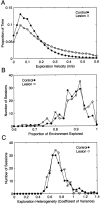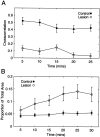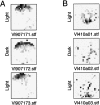Long-term effects of permanent vestibular lesions on hippocampal spatial firing
- PMID: 12878690
- PMCID: PMC6740646
- DOI: 10.1523/JNEUROSCI.23-16-06490.2003
Long-term effects of permanent vestibular lesions on hippocampal spatial firing
Abstract
The hippocampus is thought to be important for spatial representation processes that depend on the integration of both self-movement and allocentric cues. The vestibular system is a particularly important source of self-movement information that may contribute to this spatial representation. To test the hypothesis that the vestibular system provides self-movement information to the hippocampus, rats were given either a bilateral labyrinthectomy (n = 6) or a sham surgery (n = 6), and at least 60 d after surgery hippocampal CA1 neurons were recorded extracellularly while the animals foraged freely in an open arena. Recorded cells were classified as complex spiking (n = 80) or noncomplex spiking (n = 33) neurons, and their spatial firing fields (place fields) were examined. The most striking effect of the lesion was that it appeared to completely abolish location-related firing. The results of this and previous studies provide converging evidence demonstrating that vestibular information is processed by the hippocampus. The disruption of the vestibular input to the hippocampus may interfere with the reconciliation of internal self-movement signals with the changes to the external sensory inputs that occur as a result of that movement. This would disrupt the ability of the animal to integrate allocentric and egocentric information into a coherent representation of space.
Figures









Similar articles
-
Vestibular information is required for dead reckoning in the rat.J Neurosci. 2002 Nov 15;22(22):10009-17. doi: 10.1523/JNEUROSCI.22-22-10009.2002. J Neurosci. 2002. PMID: 12427858 Free PMC article.
-
Vestibular influences on CA1 neurons in the rat hippocampus: an electrophysiological study in vivo.Exp Brain Res. 2004 Mar;155(2):245-50. doi: 10.1007/s00221-003-1725-9. Epub 2003 Dec 10. Exp Brain Res. 2004. PMID: 14666395
-
Lesions of the vestibular system disrupt hippocampal theta rhythm in the rat.J Neurophysiol. 2006 Jul;96(1):4-14. doi: 10.1152/jn.00953.2005. J Neurophysiol. 2006. PMID: 16772515
-
Place cells and place navigation.Proc Natl Acad Sci U S A. 1997 Jan 7;94(1):343-50. doi: 10.1073/pnas.94.1.343. Proc Natl Acad Sci U S A. 1997. PMID: 8990211 Free PMC article. Review.
-
The effects of vestibular lesions on hippocampal function in rats.Prog Neurobiol. 2005 Apr;75(6):391-405. doi: 10.1016/j.pneurobio.2005.04.004. Prog Neurobiol. 2005. PMID: 15936135 Review.
Cited by
-
Glutamate receptor subunit and calmodulin kinase II expression, with and without T maze training, in the rat hippocampus following bilateral vestibular deafferentation.PLoS One. 2013;8(2):e54527. doi: 10.1371/journal.pone.0054527. Epub 2013 Feb 7. PLoS One. 2013. PMID: 23408944 Free PMC article.
-
Vestibular Modulation of Long-Term Potentiation and NMDA Receptor Expression in the Hippocampus.Front Mol Neurosci. 2020 Aug 11;13:140. doi: 10.3389/fnmol.2020.00140. eCollection 2020. Front Mol Neurosci. 2020. PMID: 32848601 Free PMC article.
-
The effects of bilateral vestibular loss on hippocampal volume, neuronal number, and cell proliferation in rats.Front Neurol. 2012 Feb 28;3:20. doi: 10.3389/fneur.2012.00020. eCollection 2012. Front Neurol. 2012. PMID: 22403568 Free PMC article.
-
Learning on Jupiter, learning on the Moon: the dark side of the G-force. Effects of gravity changes on neurovascular unit and modulation of learning and memory.Front Behav Neurosci. 2012 Sep 24;6:64. doi: 10.3389/fnbeh.2012.00064. eCollection 2012. Front Behav Neurosci. 2012. PMID: 23015785 Free PMC article.
-
Personality changes in patients with vestibular dysfunction.Front Hum Neurosci. 2013 Oct 29;7:678. doi: 10.3389/fnhum.2013.00678. Front Hum Neurosci. 2013. PMID: 24194706 Free PMC article. Review.
References
-
- Bannerman DM, Gilmour G, Norman G, Lemaire M, Iversen SD, Rawlins JN ( 2001) The time course of the hyperactivity that follows lesions or temporary inactivation of the fimbria-fornix. Behav Brain Res 120: 1-11. - PubMed
-
- Basile AS, Brichta AM, Harris BD, Morse D, Coling D, Skolnick P ( 1999) Dizocilpine attenuates streptomycin-induced vestibulotoxicity in rats. Neurosci Lett 265: 71-74. - PubMed
-
- Berger TW, Rinaldi PC, Weisz DJ, Thompson RF ( 1983) Single-unit analysis of different hippocampal cell types during classical conditioning of rabbit nictitating membrane response. J Neurophysiol 50: 1197-1219. - PubMed
-
- Bilkey DK, Muir GM ( 1999) A low cost, high precision subminiature microdrive for extracellular unit recording in behaving animals. J Neurosci Methods 92: 87-90. - PubMed
-
- Bilkey DK, Russell NA, Colombo M ( 2003) A lightweight microdrive for single unit recording in freely moving rats and pigeons. Methods 30: 152-158. - PubMed
Publication types
MeSH terms
LinkOut - more resources
Full Text Sources
Miscellaneous
